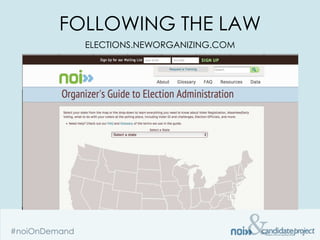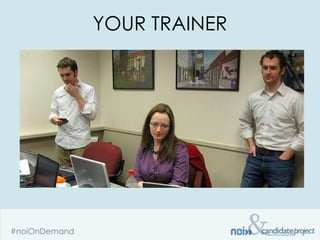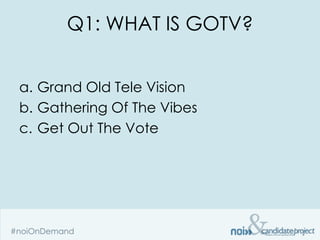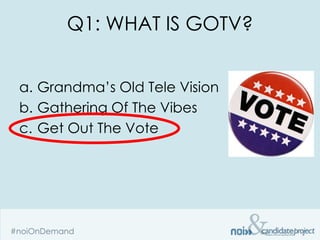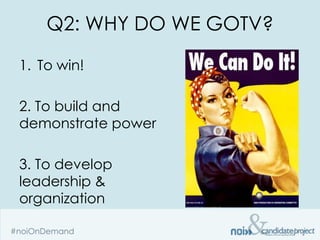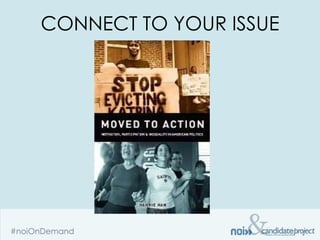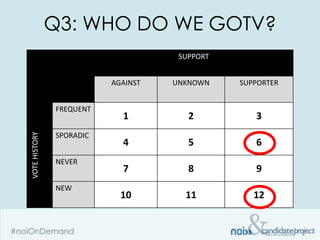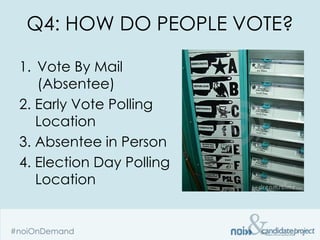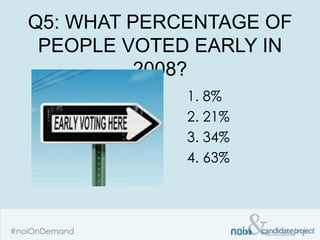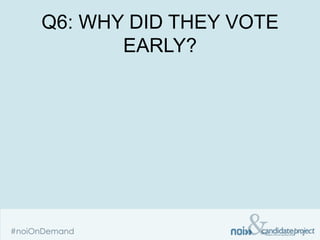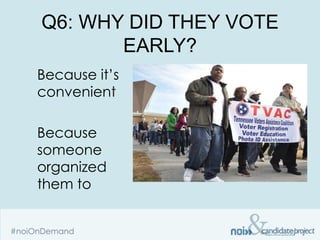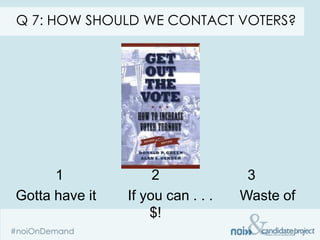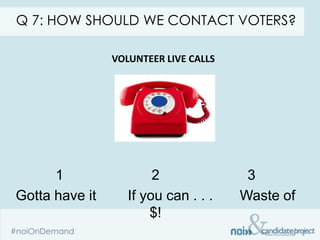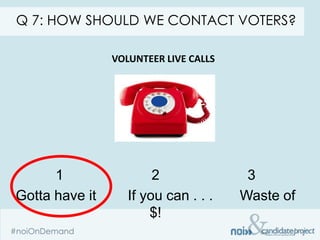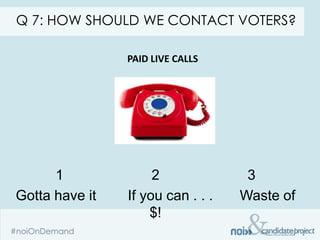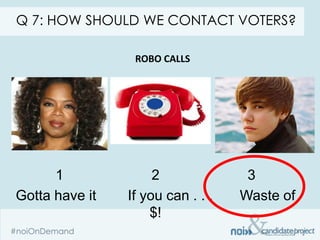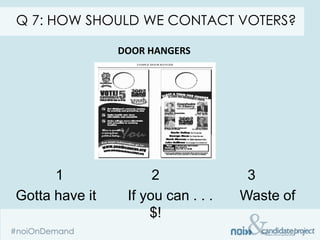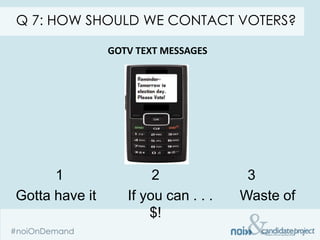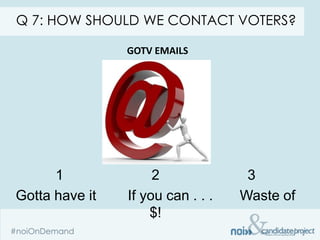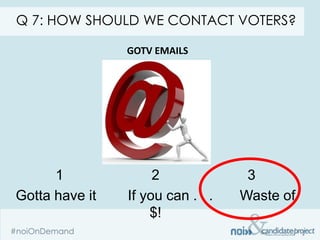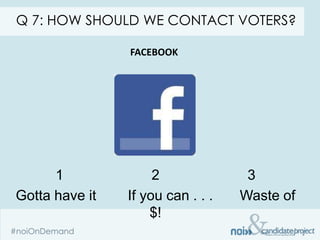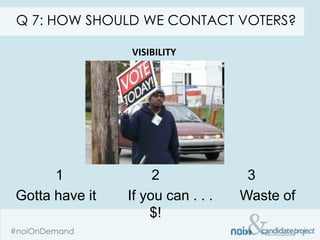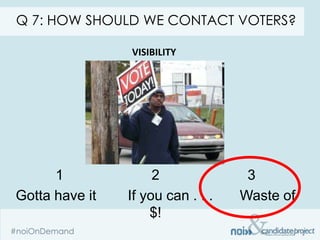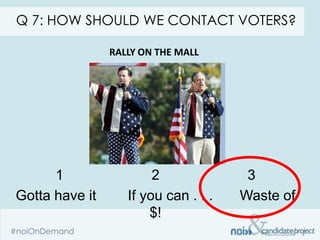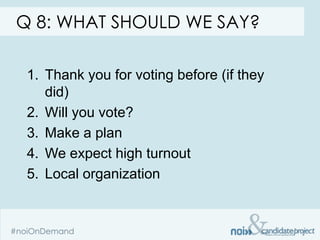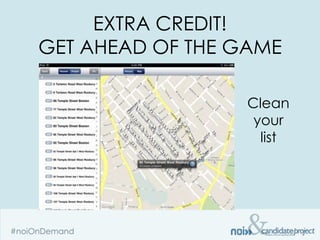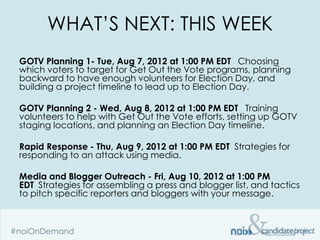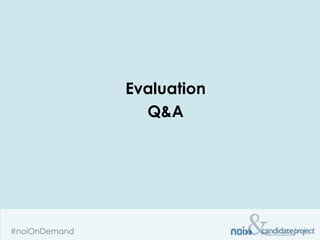Intro to GOTV
- 1. GETTING OUT YOUR VOTE Joy Cushman New Organizing Institute
- 2. INTRODUCTIONS NOI On Demand You Norms
- 3. FOLLOWING THE LAW ELECTIONS.NEWORGANIZING.COM
- 4. FOLLOWING THE LAW WWW.AFJ.ORG
- 5. YOUR TRAINER
- 6. AGENDA What is GOTV? Why do GOTV? Who do we GOTV? How do we GOTV? Get ahead of the game Next Steps, Q&A
- 8. Q1: WHAT IS GOTV? a. Grand Old Tele Vision b. Gathering Of The Vibes c. Get Out The Vote
- 9. Q1: WHAT IS GOTV? a. Grandma’s Old Tele Vision b. Gathering Of The Vibes c. Get Out The Vote
- 10. Q2: WHY DO WE GOTV? 1. 2. 3.
- 11. Q2: WHY DO WE GOTV? 1. To win! 2. To build and demonstrate power 3. To develop leadership & organization
- 12. CONNECT TO YOUR ISSUE
- 13. Q3: WHO DO WE GOTV? SUPPORT AGAINST UNKNOWN SUPPORTER FREQUENT 1 2 3 VOTE HISTORY SPORADIC 4 5 6 NEVER 7 8 9 NEW 10 11 12
- 14. Q3: WHO DO WE GOTV? SUPPORT AGAINST UNKNOWN SUPPORTER FREQUENT 1 2 3 VOTE HISTORY SPORADIC 4 5 6 NEVER 7 8 9 NEW 10 11 12
- 15. Q4: HOW DO PEOPLE VOTE? 1. 2. 3. 4.
- 16. Q4: HOW DO PEOPLE VOTE? 1. Vote By Mail (Absentee) 2. Early Vote Polling Location 3. Absentee in Person 4. Election Day Polling Location
- 17. Q5: WHAT PERCENTAGE OF PEOPLE VOTED EARLY IN 2008? 1. 8% 2. 21% 3. 34% 4. 63%
- 18. Q5: WHAT PERCENTAGE OF PEOPLE VOTED EARLY IN 2008? 1. 8% 2. 21% 3. 34% 4. 63%
- 19. Q6: WHY DID THEY VOTE EARLY?
- 20. Q6: WHY DID THEY VOTE EARLY? Because it’s convenient Because someone organized them to
- 21. Q 7: HOW SHOULD WE CONTACT VOTERS? 1 2 3 Gotta have it If you can . . . Waste of $!
- 22. Q 7: HOW SHOULD WE CONTACT VOTERS? VOLUNTEER LIVE CALLS 1 2 3 Gotta have it If you can . . . Waste of $!
- 23. Q 7: HOW SHOULD WE CONTACT VOTERS? VOLUNTEER LIVE CALLS 1 2 3 Gotta have it If you can . . . Waste of $!
- 24. Q 7: HOW SHOULD WE CONTACT VOTERS? PAID LIVE CALLS 1 2 3 Gotta have it If you can . . . Waste of $!
- 25. Q 7: HOW SHOULD WE CONTACT VOTERS? PAID LIVE CALLS 1 2 3 Gotta have it If you can . . . Waste of $!
- 26. Q 7: HOW SHOULD WE CONTACT VOTERS? ROBO CALLS 1 2 3 Gotta have it If you can . . . Waste of $!
- 27. Q 7: HOW SHOULD WE CONTACT VOTERS? ROBO CALLS 1 2 3 Gotta have it If you can . . . Waste of $!
- 28. Q 7: HOW SHOULD WE CONTACT VOTERS? DOOR TO DOOR 1 2 3 Gotta have it If you can . . . Waste of $!
- 29. Q 7: HOW SHOULD WE CONTACT VOTERS? DOOR TO DOOR 1 2 3 Gotta have it If you can . . . Waste of $!
- 30. Q 7: HOW SHOULD WE CONTACT VOTERS? GLOSSY MAIL 1 2 3 Gotta have it If you can . . . Waste of $!
- 31. Q 7: HOW SHOULD WE CONTACT VOTERS? GLOSSY MAIL 1 2 3 Gotta have it If you can . . . Waste of $!
- 32. Q 7: HOW SHOULD WE CONTACT VOTERS? DOOR HANGERS 1 2 3 Gotta have it If you can . . . Waste of $!
- 33. Q 7: HOW SHOULD WE CONTACT VOTERS? DOOR HANGERS 1 2 3 Gotta have it If you can . . . Waste of $!
- 34. Q 7: HOW SHOULD WE CONTACT VOTERS? GOTV TEXT MESSAGES 1 2 3 Gotta have it If you can . . . Waste of $!
- 35. Q 7: HOW SHOULD WE CONTACT VOTERS? GOTV TEXT MESSAGES 1 2 3 Gotta have it If you can . . . Waste of $!
- 36. Q 7: HOW SHOULD WE CONTACT VOTERS? GOTV EMAILS 1 2 3 Gotta have it If you can . . . Waste of $!
- 37. Q 7: HOW SHOULD WE CONTACT VOTERS? GOTV EMAILS 1 2 3 Gotta have it If you can . . . Waste of $!
- 38. Q 7: HOW SHOULD WE CONTACT VOTERS? FACEBOOK 1 2 3 Gotta have it If you can . . . Waste of $!
- 39. Q 7: HOW SHOULD WE CONTACT VOTERS? FACEBOOK 1 2 3 Gotta have it If you can . . . Waste of $!
- 40. Q 7: HOW SHOULD WE CONTACT VOTERS? VISIBILITY 1 2 3 Gotta have it If you can . . . Waste of $!
- 41. Q 7: HOW SHOULD WE CONTACT VOTERS? VISIBILITY 1 2 3 Gotta have it If you can . . . Waste of $!
- 42. Q 7: HOW SHOULD WE CONTACT VOTERS? RALLY ON THE MALL 1 2 3 Gotta have it If you can . . . Waste of $!
- 43. Q 7: HOW SHOULD WE CONTACT VOTERS? RALLY ON THE MALL 1 2 3 Gotta have it If you can . . . Waste of $!
- 44. Q 8: WHAT SHOULD WE SAY? 1. 2. 3. 4. 5.
- 45. Q 8: WHAT SHOULD WE SAY? 1. Thank you for voting before (if they did) 2. Will you vote? 3. Make a plan 4. We expect high turnout 5. Local organization
- 46. EXTRA CREDIT! GET AHEAD OF THE GAME Expand the electorate
- 47. EXTRA CREDIT! GET AHEAD OF THE GAME Clean your list
- 48. EXTRA CREDIT! GET AHEAD OF THE GAME Make sure your people can vote easily
- 50. WHAT’S NEXT: THIS WEEK GOTV Planning 1- Tue, Aug 7, 2012 at 1:00 PM EDT 
Choosing which voters to target for Get Out the Vote programs, planning backward to have enough volunteers for Election Day, and building a project timeline to lead up to Election Day. GOTV Planning 2 - Wed, Aug 8, 2012 at 1:00 PM EDT 
Training volunteers to help with Get Out the Vote efforts, setting up GOTV staging locations, and planning an Election Day timeline. Rapid Response - Thu, Aug 9, 2012 at 1:00 PM EDT
Strategies for responding to an attack using media. Media and Blogger Outreach - Fri, Aug 10, 2012 at 1:00 PM EDT
Strategies for assembling a press and blogger list, and tactics to pitch specific reporters and bloggers with your message.
- 51. WHAT’S NEXT: NEXT WEEK Managing Staff and Volunteers - Mon, Aug 13, 2012 at 1:00 PM EDT 
Best practices for setting expectations and goals, communicating with staff, hiring, delegating responsibility, and providing feedback. Leading a Data-Driven Action Program - Tue, Aug 14, 2012 at 1:00 PM EDT
Strategic ways to think about data, including best uses of limited resources, setting strategic goals and maintaining accountability, and demonstrating success. Volunteer Recruitment and Capacity Planning - Wed, Aug 15, 2012 at 1:00 PM EDT 
Strategies for identifying and recruiting volunteers, planning for long-term capacity to start a volunteer program, and ramping up to Election Day. Using New Media to Tell the Story - Thu, Aug 16, 2012 at 1:00 PM EDT
How to use New Media to construct a narrative and history for your campaign. Email Campaigning - Fri, Aug 17, 2012 at 1:00 PM EDT
The use of email in campaigns, review strategies and best practices for writing effective emails, and tips and a checklist for making your email program a success.
- 52. Evaluation Q&A
Editor's Notes
- #3: NOINOI on DemandIntroduce Hope who will do the polls and manage the chat boxParticipants (c3, c4, candidate/party), intros in chat boxNorms for Webinar: chat, raise hands, there are no stupid questions
- #4: Hire legal adviceAlliance for Justice (c3)OGEA
- #5: Hire legal adviceAlliance for Justice (c3)OGEA
- #10: Thomas Jefferson, 1787“We in America do not have government by the majority. We have government by the majority who participate.”
- #12: Need power to govern after EdayPAZ, AZ example
- #13: Hahrie Han, people are more likely to participate in civic engagement if the action they are taking is clearly connected to their values and the issues they care about.
- #14: Our constituents (supporters & members)GOTV grid
- #15: Our constituents (supporters & members)GOTV grid
- #16: By what method?
- #17: FL example
- #21: Instead of visibility do a march to the polls
- #22: Based on Gerber & Green, Analyst Institute and other researchGerber and Green, 2008
- #23: Add other pics.Based on Gerber & Green, Analyst Institute and other research
- #24: Based on Gerber & Green, Analyst Institute and other researchSlow, conversational, politics, not telemarketing
- #25: Add other pics.Based on Gerber & Green, Analyst Institute and other research
- #26: Based on Gerber & Green, Analyst Institute and other research**If they’re well monitored and well coachedQuick conversations do nothing to increase turnout
- #27: Based on Gerber & Green, Analyst Institute and other research
- #28: Add other pics.Based on Gerber & Green, Analyst Institute and other research
- #29: Based on Gerber & Green, Analyst Institute and other researchDoor to door is “old school”—what???!!!
- #30: Add other pics.Based on Gerber & Green, Analyst Institute and other researchDoor to door is “old school”—what???!!!
- #32: Based on Gerber & Green, Analyst Institute and other researchWaste of money for GOTV. But can work for persuasionBased on Gerber & Green, Analyst Institute and other researchNon partisan mail increases turnout 1 out of 200 voters (1/2%)Partisan mail does not increase turnout except possibly in the baseWhat does increase turnout is self addressed pledge reminder cards, or handwritten mail.
- #33: Add other pics.Based on Gerber & Green, Analyst Institute and other researchAdd where to vote, or a # or site to find out where to voteVIP
- #34: Based on Gerber & Green, Analyst Institute and other researchAdd where to vote, or a # or site to find out where to voteVIP10% effect of door knocking
- #35: Add other pics.Based on Gerber & Green, Analyst Institute and other researchAdd where to vote, or a # or site to find out where to voteVIP
- #36: Add other pics.Based on Gerber & Green, Analyst Institute and other researchAdd where to vote, or a # or site to find out where to voteVIP
- #37: Use them for volunteer recruitment
- #38: Use them for volunteer recruitment
- #39: Use them for volunteer recruitment
- #40: Holly TeresiSome impact on turnout through posts (not testing ads)
- #42: Don’t pay for it! If you’re going to do it, do it for volunteer motivation then head out to knock doors
- #43: Use them for volunteer recruitment
- #44: But helpful in your precinct. Can raise precinct-wide turnout 1-2 percent
- #47: Register voters everywhere (Obama Florida)
- #48: Phases of your campaign—using all stages helps clean your list.
- #49: We don’t want long lines. Build a relationship with your election administration staff now to help set up more early vote locations and to ensure that polling places in your precincts have adequate and functional voting machines. Don’t wait til Election Day to report problems—at that point it’s too late!
- #50: Tally up your quiz
- #51: Add a review of the weekFill out the evaluationQ&A
- #52: Add a review of the weekFill out the evaluationQ&A
- #53: Add a review of the weekFill out the evaluationQ&A


